A comprehensive Arab plan, led by Egypt, aims to rebuild the war-torn Gaza Strip with an estimated budget of $53 billion. This figure was highlighted in a joint report by the UN, EU, and World Bank last month. However, the plan has faced significant criticism for failing to address major issues such as governance, Hamas’ future, and securing funding.
The White House and Israel have both rejected the proposal. The U.S. National Security Council stated that the plan does not sufficiently address Gaza’s current uninhabitable conditions. Instead, Washington continues to endorse former President Donald Trump’s vision of transforming Gaza into a “Riviera of the Middle East,” a proposal that has been met with Arab opposition.
The Reconstruction Plan
The nearly 100-page proposal, titled Gaza 2030, carries Egypt’s presidential seal and was recently reviewed at an emergency Arab summit in Cairo. The plan’s objective is to rebuild Gaza while sidelining Hamas and restoring control to the Palestinian Authority. The summit’s final statement called upon the international community and financial institutions to provide urgent support. However, the source of funding remains unclear, though contributions from the EU, Saudi Arabia, and Qatar are considered potential options.
Despite its ambitious scope, experts have cast doubt on the feasibility of the plan. Paul Musgrave, a professor at Georgetown University in Qatar, told CNBC that the proposal sidesteps two critical issues: whether Hamas would accept the required political conditions and whether Israel would allow a Palestinian Authority-led administration to govern Gaza again.
Israel has rejected the proposal outright, arguing that any aid or ceasefire extensions should be contingent on Hamas releasing all remaining Israeli hostages. Israel’s Foreign Ministry criticized the plan, calling it outdated and failing to reflect post-October 7, 2023, realities. In contrast, the Trump administration’s approach has received Israeli support.
Meanwhile, Arab nations have proposed an international conference on Gaza’s reconstruction, scheduled to take place in Cairo in coordination with the UN. They also announced plans to establish a trust fund, overseen by the World Bank, to manage financial pledges from donor countries and institutions.
Three-Phase Rebuilding Process
The Gaza 2030 plan outlines a structured three-phase reconstruction process spanning six years:
-
Phase One (6 months, $3 billion)
- Clearing rubble in select areas
- Establishing seven temporary housing sites for over 1.5 million displaced people
-
Phase Two (2 years, $20 billion)
- Constructing permanent housing for 1.6 million people
- Restoring essential services, infrastructure, and public facilities
-
Phase Three (2.5 years, $30 billion)
- Expanding infrastructure, public services, and networks
- Building additional housing units for 1.2 million people, with a goal to accommodate 3 million residents in total
Governance and Hamas’ Future
A major gap in the proposal is the absence of a clear framework for Hamas’ role in Gaza’s future. The plan suggests that during an initial six-month transitional period, an independent committee of technocrats, unaffiliated with any political factions, would oversee Gaza’s administration under the Palestinian government’s umbrella. The ultimate goal is to restore full Palestinian Authority control over the strip.
Arab leaders have also called for general elections within a year, provided that conditions allow. In response, a senior Hamas political official told CNBC that the group welcomes elections, calling them a long-standing demand that would allow Palestinians to democratically choose their leadership and political future.
However, key uncertainties remain, particularly concerning Hamas’ disarmament. While Hamas acknowledged the Arab plan contains “positive elements,” its willingness to comply with the outlined governance transition remains unclear.
Despite broad international discussions, the path forward remains fraught with challenges, including securing funding, gaining Israeli cooperation, and navigating Hamas’ uncertain future in Gaza.

















